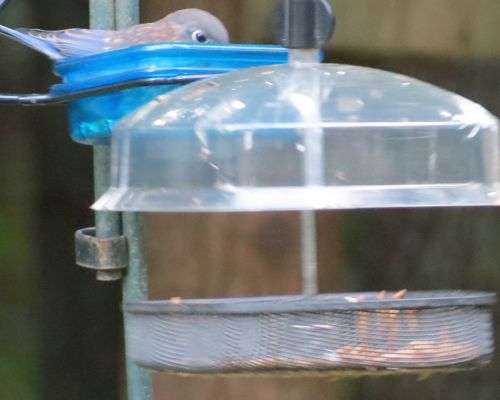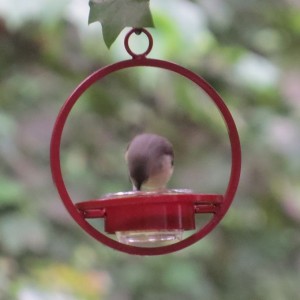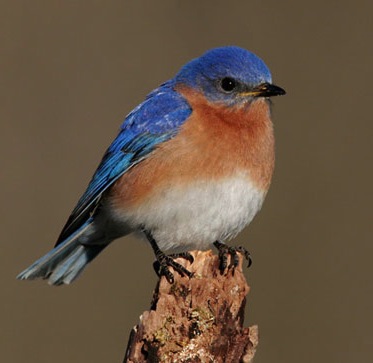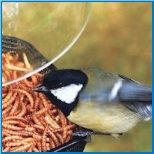-
Opportunistic Robins and More Wait Below this Mealworm Feeder
The worms crawl in-the worms crawl out… of some mealworm feeders!
See them in the back, on the right side? Escapees! It’s problematic enough when cat birds and cardinals and warblers start in on your live worms, after all-they’re meant for the bluebirds. Recent fledges are learning to use the feeders, so it’s a real bummer when they figure it out and it’s empty 🙁
Robins, chipping sparrows, cardinals, towhees, chickadees, titmice and still others have learned that sometimes it rains worms. They’ll sit below this screened mealworm feeder and wait for the manna to fall… and it does.
Not to say the design is sub-par, just maybe not the best choice for offering live mealies. Dried worms and other bluebird treats are ideal in this hanging feeder, but the tooth (screen texture) gives the live ones a good grip and path to exit stage left!
The new steel Orb Feeder features an acrylic cup, a nice smooth surface that keeps worms put, that is until titmice and chickadees discover them. And the blue dish shown above is also a nice smooth surface, one from where worms can not escape.
Something we’ve experimented with this season (and is quite successful) is offering more of the dried worms – much more economical. But the trick is to soften them first so that parents will feed them babies. Steeping dried meal worms in boiling water for about ten minutes-then draining, is ideal if you’re a backyard bird freak like us 🙂
So a good basic rule of thumb is that live worms do much better when placed on a smooth surface! Should too many worms be disappearing altogether, an enclosed feeder is likely best. Bluebirds are one of the few who will “fly-in” a feeder. Without fail, Carolina wrens are always the first to figure it out!
With so many new fledges out and about, it’s a great time to try offering mealworms if you never have in the past. One way to stretch worms and make them lat longer is to use a mixture. One of our recipes includes a no-melt suet cake (crumbled), shelled peanuts and a few sunflower hearts… the birds love it!
-
Confessions from the Mealworm Feeder
Addiction can be a terrible thing… and I fear that feeding worms has actually become one!
So the worms are meant for this guy, his spouse and kids. Okay, the chickadees can have some, the titmice can too because they have nestlings to feed. Brown headed nuthatches stick around their box long after babies have fledged, they’re too much and may need a permanent address? For the first time phoebe finally has a family (that I’ve actually seen anyway) so of course they must take turns at the mealworm feeder – may you grow strong and thrive little phoebes!
Cardinals won’t touch worms… until they have babies to feed. The catbirds are simply out of hand, wish they’d just stick to the grape jelly! Have you ever seen 20,000 meal worms in a plastic shoe box heading for dormancy in the fridge? It’s become the norm as live worms cost less when buying in bulk. The worms aren’t bad, but the overnight shipping can kill ya!
Using this open dish as one of the mealworm feeders is really just asking for it, but babies can’t figure out the enclosed bluebird feeders, or jail type ones with open grid cage. Carolina wrens certainly can, they’re always the first to figure out any new feeder containing mealies!
Screen feeders are nice and easy to use for humans and birds alike… but the worms crawl out! Anything with texture or tooth worms can grip allows cling and crawl action! No worries, anyone who drops to the ground meets their fate by a robin or thrasher just waiting below for the great escape!
So the addiction? The grower must think I eat worms myself, the quantity has now increased to 25,000 worms a pop… and this is every four weeks or so. And I wonder why I’m broke?
- Bird Accessories, Bird Feeders, Bluebird Feeders, Fruit, Jelly & Mealworm Feeders, Mealworm Feeder, Recycled Bird Feeders, Uncategorized, Window Bird Feeder
Add a Mealworm Feeder to Entice Bluebirds
Bluebi
rds covet mealworms, in fact, I’ve discovered that lots of birds love these tasty morsels. In trying to attract bluebirds to this North Georgia yard, first came the bluebird house…but no luck. Then came a bluebird feeder, you know, the kind with the entrance holes that supposedly only bluebirds will fly into for food. Unfortunately that didn’t seem to work either, every different “bluebird delight” on the market was used.
After some quick research, it seemed live mealworms would do the trick, so I squeamishly ordered the first batch. They weren’t too bad, as long as I didn’t have to touch them! Unpacking and storing that first batch was pretty funny looking back at it now. Newspaper spread on the counter, latex gloves, and a semi-faint heart about the whole thing. Then just knowing I had a container of live worms in the fridge…omg! But I wanted to see bluebirds – so I persevered.
Not only did it work, it worked great…Eastern Bluebirds in my yard finally. Two or three showed up at first, and then they began to build a nest in the house. Watching the daily activity was fantastic. A few weeks later the babies started to fledge, one, two, three, four of th
em, all following mom and dad. Truly a great season! It didn’t take long for them to figure out how to enter the mealworm feeder and retrieve their own worms at will. The coolest thing is there was a second successful brood that season too. Watching the juveniles with the new fledgelings was absolutely awesome. Now I’m addicted to meal worms just as much as my bluebirds are. Making sure to feed them twice every day, close to the same time. My new friends stuck around all winter, likely due to the three heated birdbaths, and the regular feeding schedule.
Traditional bluebird feeders aren’t the only way to offer mealworms to feathered friends. Many dish-type styles have attachments for poles, making it simple to add a mealworm feeder to any existing feeding station. Tray type or platform feeders also have the capacity for worms, but there’s no guarantee the bluebirds will get them first. Maybe that’s where the saying “early bird catches the worm” comes from?
This recycled plastic mealworm feeder easily mounts to any standard one-inch diameter pole. The wooden Siamese Cat has a metal screen tray that’s perfect for offering worms too. The best part about these types of feeders is versatility. Foods like suet, peanuts and fruit may also be offered, depending on the species you’d like to attract and season.







